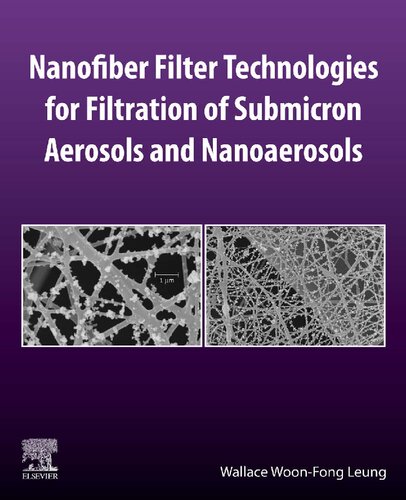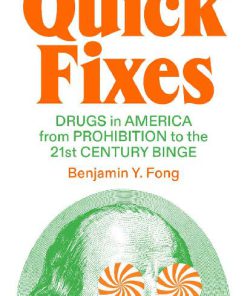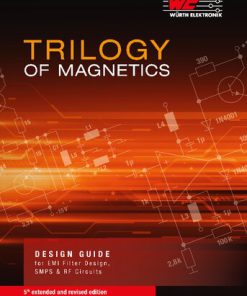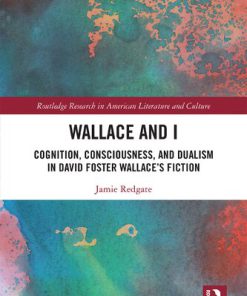Nanofiber Filter Technologies for Filtration of Submicron Aerosols and Nanoaerosols 1st Edition by Wallace Woon Fong Leung ISBN 9780128244685 0128244682
$50.00 Original price was: $50.00.$25.00Current price is: $25.00.
Nanofiber Filter Technologies for Filtration of Submicron Aerosols and Nanoaerosols 1st Edition by Wallace Woon Fong Leung – Ebook PDF Instant Download/Delivery: 9780128244685 ,0128244682
Full download Nanofiber Filter Technologies for Filtration of Submicron Aerosols and Nanoaerosols 1st Edition after payment

Product details:
ISBN 10: 0128244682
ISBN 13: 9780128244685
Author: Wallace Woon Fong Leung
Nanofiber Filter Technologies for Filtration of Submicron Aerosols and Nanoaerosols covers the nanoaerosols (less than 100 nanometers) to larger submicron aerosols due mostly to pollution, which are present in high number concentration in our surroundings. People are breathing these nanoaerosols daily without being aware of it. Airborne viruses from flu to coronaviruses are also nanoaerosols. During the COVID-19 pandemic, it took a long time for health authorities and the General Public to recognize the airborne transmission mode of the virus. This leads to inadequate protection and ineffective virus control strategies resulting in high infection and death rates. The book cites evidence and observations pointing to the airborne transmission mode of the coronavirus. It also discusses different filtration technologies using nanofibers to capture these aerosols for short-term filtration, where aerosols are trapped in the filter (depth filtration), and long-term filtration, where aerosols are trapped in the growing filter cake (cake filtration). This book provides a good understanding on how nanofibers, which is of size 1/1000 times that of a normal human hair, can effectively filter these tiny aerosols. NFT, organized in four sections – fundamentals, deep understanding, technologies, and application, covering comprehensively on the subject, is a valuable resource for undergraduates and graduates, engineers, researchers and practitioners in related industries.
- Describes technologies with insight and use basic engineering principles to build-up technologies
- Includes extensive clear and understandable figures and tables to enhance key concepts
- Uses examples throughout to explain engineering principles and interdisciplinary concepts
- The only book in the market focusing on nanofiber filter technologies for filtering submicron aerosols and nanoaerosols
Nanofiber Filter Technologies for Filtration of Submicron Aerosols and Nanoaerosols 1st Edition Table of contents:
Chapter one. Introduction to submicron aerosols and nanoaerosols
Abstract
1.1 Aerosols
1.2 Classification
1.3 Indoor aerosols
1.4 Outdoor aerosols
1.5 Health implication of nanoaerosols
1.6 Airborne viruses
1.7 Respiratory droplet and airborne virus transmission
1.8 Experiment on SARS-CoV-2 virus spread by air transmission
1.9 Approach to filter submicron aerosols and nanoaerosols
1.10 Summary
1.11 Problems
References
Chapter two. Fundamentals of gas filtration of submicron aerosols and nanoaerosols
Abstract
2.1 Introduction
2.2 Filter and single-fiber efficiency
2.3 Mechanical capture
2.4 Example of mechanical capture
2.5 Typical behavior of mechanical capture
2.6 Electrostatic effect
2.7 Pressure drop
2.8 Summary
2.9 Problems
References
Chapter three. Nanofiber production
Abstract
3.1 Electrospinning using needle-less electrospinning with a solvent-based approach
3.2 Production using needle electrospinning with a solvent-based approach
3.3 Electrospinning of molten state using needle electrospinning
3.4 Centrifugal electrospinning with a high production rate
3.5 Forcespinning
3.6 The production of nanofibers using island-in-sea technology
3.7 Examples of the production of different polymeric nanofibers
3.8 Summary
3.9 Problems
References
Chapter four. Filter testing, filter test standards, and filter ratings
Abstract
4.1 Introduction
4.2 Sodium chloride test aerosol (monodisperse)
4.3 Dioctyl phthalate test aerosols
4.4 Commercial filter tester
4.5 Scanning mobility particle sizer
4.6 Silver nanoparticles
4.7 Polystyrene latex test aerosols
4.8 Comparing filtration efficiencies of a clean filter with different test aerosols
4.9 ISO test dust
4.10 Filter loading acceleration test
4.11 Face mask
4.12 Respirator test
4.13 MERV ratings and heating, ventilation, and air conditioning test
4.14 Summary
4.15 Problems
References
Chapter five. Filtration characteristics of nanofiber filter and multilayer nanofiber filter for depth filtration
Abstract
5.1 Introduction
5.2 Single-layer polymeric nanofiber filter
5.3 Fiber packing density and filter thickness
5.4 PEO nanofiber filter
5.5 Pressure drop versus fiber basis weight for a single-layer nanofiber filter
5.6 Filter thickness and fiber packing density versus fiber basis weight
5.7 Grade filtration efficiency, prediction versus measurements
5.8 Most penetrating particle size (MPPS)
5.9 Multilayer nanofiber filter
5.10 Summary
5.11 Problems
References
Chapter six. Transition from depth-to-surface filtration for a nanofiber filter
Abstract
6.1 Depth filtration and skin layer
6.2 Transition from depth-to-cake filtration
6.3 Transition—capillary filling model
6.4 Transition—bridging model
6.5 Cake formation model
6.6 High-skin filter case studies
6.7 Permeability of skin layer
6.8 Remarks on high-skin effect study
6.9 Low-skin filter
6.10 Cake thickness
6.11 Low-skin case studies
6.12 Remarks on low-skin studies
6.13 Summary
6.14 Problems
References
Chapter seven. Cake filtration with a composite micro–nanofiber filter
Abstract
7.1 Introduction
7.2 Combining composite filters with different properties
7.3 Cake filtration theory
7.4 Tests on different composite filters
7.5 Aerosol loading test results on single and composite filters
7.6 Dimensionless cake deposition–resistance ratio, β
7.7 Cake deposition pattern
7.8 Summary
7.9 Problems
References
Chapter eight. Electret filter for depth and cake filtration
Abstract
8.1 Introduction to electrostatic effects
8.2 Determining dielectrophoretic single-fiber efficiency
8.3 Single fiber efficiency for charged microfiber versus nanofiber
8.4 Effect of face velocity
8.5 Single versus multiple modules for unloaded filter
8.6 Aerosol loading in filters
8.7 Loading behavior of single-module uncharged (SU) PVDF filter
8.8 Loading behavior of multimodule uncharged (MU) filter
8.9 Loading behaviors of single-module charged (SC) filter
8.10 Loading behavior of multimodule charged (MC) filter
8.11 Analyses of filter efficiency, capacity, and pressure drop
8.12 Summary
8.13 Problems
References
Chapter nine. Numerical modeling of aerosol filtration using a nanofiber filter
Abstract
9.1 What numerical modeling can contribute?
9.2 Theoretical model
9.3 Aerosol deposition model
9.4 Deposition of polydispersed nanoaerosols
9.5 Concluding remarks on 2D model with a single-layer nanofiber filter
9.6 Composite filter, including nanofiber layer
9.7 Clean filter simulation—random 3D mesh generation
9.8 Clean filter simulation—Image-based simulation model
9.9 Clean filter simulation–added electrostatic force
9.10 Clean filter simulation—lattice Boltzmann method with added electrostatic and van der Waals forces
9.11 Summary
9.12 Problems
References
Chapter ten. Cleaning of nanofiber filter
Abstract
10.1 Introduction
10.2 Test filter
10.3 Aerosol distribution in a loaded filter
10.4 Filter cleaning
10.5 Cleaning behavior of nanofiber filter
10.6 Cleaning model
10.7 Comparing model predictions with test results on filter cleaning
10.8 Summary
10.9 Problems
References
Chapter eleven. Nanofiber filter reuse—repeated loading–cleaning cycles
Abstract
11.1 Introduction
11.2 Tests on cyclic loading/cleaning
11.3 Aerosol loading models
11.4 Pressure excursion over loading followed by cleaning
11.5 Summary
11.6 Problems
References
Chapter twelve. Filtration of ambient aerosols
Abstract
12.1 Filter tests with real aerosols
12.2 Theoretical consideration
12.3 Tests with real aerosols
12.4 Test results of traffic and ambient aerosols
12.5 Polyvinylidene difluoride multimodule filter
12.6 Ambient aerosols as a simulation of SARS-CoV-2 virus carrier
12.7 Single-fiber efficiency for charged nanofiber filter
12.8 Charged multilayer/multimodule nanofiber filter for filtering ambient aerosol
12.9 Achieving high efficiency with higher nanofiber basis weight by multilayering
12.10 Comparing ambient aerosol with sodium chloride aerosol in filter test
12.11 Summary
12.12 Problems
References
Chapter thirteen. Applications of nanofiber filters
Abstract
13.1 Introduction
13.2 Pleated cabin air filter
13.3 High-efficiency particulate air and ultralow particulate air filters
13.4 Surgical face mask
13.5 Respirators
13.6 Heating ventilation and air conditioning with cake formation
13.7 Air filter for engine of off-road vehicles
13.8 Disinfection filter
13.9 Breakdown of harmful gaseous compounds and disinfection
13.10 Summary
13.11 Problems
References
Chapter fourteen. Outlook
Abstract
14.1 Submicron aerosols and nanoaerosols
14.2 Interpretation and prediction of nanofiber filter performance
14.3 Iso-quality factor
14.4 Polymer and additional functions other than gas filtration
14.5 Large-scale production
14.6 Pressure-drop reduction strategies
14.7 Electrostatic charged nanofibers
14.8 Cleaning of preloaded nanofiber filters for reuse
14.9 Summary
References
Appendix A. Answer to problems of chapters
Chapter one
Chapter two
Chapter four
Chapter five
Chapter six
Chapter seven
Chapter eight
Chapter nine
Chapter ten
Chapter eleven
Chapter twelve
Chapter thirteen
Appendix B. Size distribution in dN/d(log(Dp))
Appendix C. Permeability and capillary radius of the skin layer
Appendix D. Cake deposition-resistance ratio, β
Appendix E. Specific filter resistance, γ
Nomenclature
Index
People also search for Nanofiber Filter Technologies for Filtration of Submicron Aerosols and Nanoaerosols 1st Edition:
nanofiber filter media
nanofiber water filter
nanofiber filtration technology
nanofiber air filter
k&f nano-x uv filter
Tags: Wallace Woon Fong Leung, Nanofiber Filter Technologies, Filtration, Submicron Aerosols
You may also like…
Politics & Philosophy - Social Sciences
Engineering - Engineering Technology
Filtration Technical Textiles 1st Edition Dr Harshvardhan Saraswat
Education Studies & Teaching - Educational Theory
Quick Fixes Jacobin 1st Edition by Benjamin Y Fong 9781804290200 1804290203
Technique - Electronics: Telecommunications
RF Filter Technology For Dummies, Qorvo 2nd Special Edition David Schnaufer
Engineering - Energy & Power Resources
Technique - Electronics: VLSI
Uncategorized
The Bird Feeder 1st edition by Andrew Larsen, Dorothy Leung ISBN 1525304836 9781525304835
Fiction - Others











